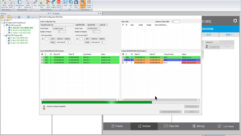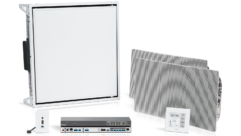AV System Improves Sightlines
With his AV integration firm on state term contract in Ohio, Nicolas Santoro was thrilled last year when he finally got a chance to ?earn his stripes? with one of the region’s larger education clients, the Northeastern Ohio University College of Medicine (NEOUCOM).
CHALLENGE: Create a display system that helps every student in two difficult viewing environments see the presentation, and design user interfaces that won’t turn off the faculty.
SOLUTION: Use multiple screens in a long, narrow lecture hall, and in a shorter, wider hall, hang two custom-designed screens angled outward so viewers can clearly see presentations. For the interface, create a simple walk-through process to deploy a fully automated AV system.
Because its short, wide building profile creates difficult viewing angles for those seated toward its sides, NEOUCOM’s Liebelt Lecture Hall features twin Stewart projection screens, custom-built for 170-degree viewing angles, and mounted side-by-side at the front of the room. To further offset the viewing challenge, each screen is slightly toed toward its respective side.
With his AV integration firm on state term contract in Ohio, Nicolas Santoro was thrilled last year when he finally got a chance to “earn his stripes” with one of the region’s larger education clients, the Northeastern Ohio University College of Medicine (NEOUCOM).
And those stripes were indeed earned for Santoro, a sales engineer for Tampa, FL-based Audio Visual Innovations (AVI), who works out of the company’s Broadview Heights, OH, office.
Santoro and his team were offered two $150,000 contracts to integrate modern AV systems in two NEOUCOM rooms already under renovation at the school’s Rootstown campus, the Olson Auditorium and the Liebelt Lecture Hall. Both facilities featured challenging display environments that required thoughtful, innovative engineering on AVI’s part.
And while it was tough to make it so everyone in the crowd could see, the technology-deprived instructors proved to be an even tougher crowd. Instructors at the school — a community-based, public institution teaching first- and second-year medical students, as well as those seeking pharmacology degrees — weren’t exactly used to using modern AV equipment.
“The biggest item we needed to address was trying to transition them from an analog world into a digital one,” says Santoro, noting that most instructors at the school relied heavily on 35 mm slide projection, whiteboards, chalkboards, and overhead transparencies in their presentations.
“Our existing environment was very antiquated,” concedes Ron McGrady, network infrastructure manager for NEOUCOM. “It hadn’t been updated since the mid-1970s. While they had some touch-panel capability in there and the ability to do some projection, there was no real central user interface. Everything was pieces and parts.”
WORKING THE ANGLES
Featuring a shallow, wide building profile and seven rows of seating accommodating 128 students, the Northeastern Ohio University College of Medicine (NEOUCOM) Liebelt Lecture Hall presented tough viewing conditions for those positioned at the sides of the room to see a center-set screen.
To overcome this, systems integrator Audio Visual Innovations (AVI) positioned two identical screens, side by side, at the front of the room, each toed out at a 10-degree angle to service their respective side of the hall.
According to AVI sales engineer Nicolas Santoro, the integrator worked with projection screen manufacturer Stewart Filmscreen to design the twin custom 6.75- by 9-foot SnoMatte screens — both of which are designed to have a viewing angle of 170 degrees.
Each screen supports the identical displays projected onto it by one of two Hitachi CP-X1250W 4,500-lumen XGA projectors. Because the system also supports dual-mode projection, and the video has to be split four ways across two screens, an RGB Spectrum QVXL-4/0 QuadView Plus display processor was integrated into the system.
“Now, there are really no bad angles in the room,” says Ron McGrady, manager of network infrastructure for NEOUCOM. “We have a special screen that was made specifically for that type of environment.”
The Wiz
Collaborating closely with McGrady and his staff, Santoro — along with AVI installation manager Chad Elliott and senior engineer Eric Haney — were able to outline NEOUCOM’s goals for the new AV system.
For the students, the goal was to create a more collaborative environment in which video reinforcements and real-time illustrations could complement graphics-based presentations in a dual-screen format.
For the instructors, the idea was to make sure they weren’t taken too far out of their comfort zone — in both rooms, they would basically be given digital versions of tools they were already familiar with, such as a Polyvision LT4000 70-inch interactive whiteboard and an Elmo HV-8000SX digital document camera.
But there would be other new technology that wasn’t as familiar, such as dual-projector, multi-screen projection systems based around Hitachi CP-X1250W 4,500-lumen XGA projectors; audio support featuring Sennheiser EW312G2 wireless microphones, a TOA IP-450D 300-watt amplifier, and an array of 26 Speco Technologies SP-6ECS 6.5-inch ceiling-recessed speakers; as well as expansion capability for video streaming and videoconferencing.
From the beginning, it was clear to Santoro that a simple user interface would be fundamental to the project. “We were dramatically changing the tools the instructors had to teach with and the amount of technology they had at their fingertips, and we had to create an environment that was very easy to use,” he says. “They didn’t want to spend $150,000 on a room and not have the faculty be able to use any of the technology.”
Programming in AMX NetLinx and creating graphics in Adobe Photoshop, AVI’s Haney designed a set-up wizard — an easy-to-use, step-by-step custom interface intended to help lead instructors through the process of turning on the AV system.
“The system asks them a set of questions, and walks them through the initial setup,” Santoro explains. Interacting with an Elo TouchSystems 1525L 15-inch touchpanel monitor, instructors are asked simple setup inquiries like “single or dual-screen format?” “DVD or VCR?” and “Is this the correct configuration you want deployed?”
“When they hit the final button, the lights dim, and the sound and video come up automatically,” McGrady says. “All the devices have all of that automated — you don’t have to be a computer programmer to have the room function.”
The system’s simplicity and automation yielded other benefits for a stretched-thin NEOUCOM support crew. “The first thing was to put in some kind of user interface that was easy to use, but we also had to minimize the number of support staff it would take to babysit the room,” Santoro adds.
Tough sightlines
While AVI’s objectives entailed designing two very similar AMX-based system infrastructures in both the Liebelt and Olson spaces, the stark architectural characteristics of each room called for very different display environments — a challenge made all the more difficult by NEOUCOM’s need for simultaneous dual-image display.
Retrofitted to include tiered seating for 128 people, the Liebelt — it’s twice as wide as it is deep — featured a very tough viewing environment for those situated on the sides of the room.
“Originally, the room was much smaller — that was part of the retrofit that was done in conjunction with the technology upgrade. They expanded the width, but the depth remained the same,” McGrady explains.
“There were very drastic seating angles to the outside, and we had to make sure everyone could see what was on the screens,” Santoro adds.
In addition to a 220-inch Draper screen mounted in front of the room, NEOUCOM’s Olson Auditorium features four Draper 38.5- by 51.25-inch screens, each ceiling mounted two to a side in the middle of the venue, to support dualsource display.
The AVI team was able to overcome that challenge by working with Stewart Filmscreen to create two custom-built 6.75- by 9-foot projection screens, then toeing each out slightly to the outside (see sidebar).
While the Liebelt is short and wide, the 140-seat Olson is long and narrow.
“We put the largest screen we could find in the front of the auditorium — a 220-inch diagonal — and single-display mode wasn’t a problem,” Santoro explains. “But the room is 65-feet long, and when you got to about 40-feet-deep on dual-screen mode, the students couldn’t easily see the computer graphics.”
Any solution would involve ceiling-hung support screens in the back portion of the auditorium, but they couldn’t be mounted in the center, otherwise the Olson would end up with the same viewing-angle problem that the short, stout Liebelt had.
After trying out numerous configurations, AVI settled on one featuring a single 220-inch Draper screen mounted in the front of the room in front of three Hitachi CP-X1250W 4,500-lumen XGA projectors mounted with Chief RPA-042 projector mounts — one to support single-screen mode, the other for dual-screen mode. Thirty-eight feet farther into the room, four 38.5- by 51.25-inch Draper Access V screens are mounted two to a side from the ceiling, each in front of a Mitsubishi XL25U 2,500-lumen XGA projector, suspended by a Chief RPA-025 ceiling mount.
AVI engineers took special care to make sure the bottoms of these support screens didn’t interfere with the sightlines of those in the back wishing to view the main screen at the front of the room.
“Honestly, having five screens and seven projectors in the room isn’t the most aesthetically pleasing thing,” Santoro concedes. “But we wanted to make sure everybody in the house got a good seat and there was no way they could say they missed something because they couldn’t see it.”
FOR MORE INFORMATION
AMXwww.amx.com
Chief Manufacturingwww.chiefmfg.com
Draperwww.draperinc.com
Elmowww.elmousa.com
Elo TouchSystemswww.elotouch.com
Hitachiwww.hitachi.us
Mitsubishiwww.mitsubishi-presentations.com
Polyvisionwww.polyvision.com
RGB Spectrumwww.rgb.com
Sennheiserwww.sennheiserusa.com
Speco Technologieswww.csi-speco.com
Stewart Filmscreenwww.stewartfilmscreen.com
TOA Electronicswww.toaelectronics.com
Planning Ahead
In addition to overcoming tricky display configuration requirements, AVI also had to wire its system for a wide variety of unique features and future expansion.
“Part of the design phase included working with the architect to put in present and future cabling needs,” says Santoro, who notes how the inclusion of headphone jacks at each seat in both auditoriums made at least one process for NEOUCOM less cumbersome.
“They’ve got this heart sound machine they roll in so students can hear what murmurs and mitral valve prolapses sound like,” he explains. “They used to have to run long cables across the floor so each student could have access to the machine with a stethoscope.” Now, students can plug in their Cardionics stethoscopes directly into the headphone jacks built into their desks.
AVI also had to wire the rooms — and configure the user interfaces — to accommodate eventual expansion into videoconferencing and videostreaming. AVI just embarked on $40,000 follow-up project to put Tandberg videoconferencing and Sonic Foundry video streaming technologies into both rooms.
“We had to think in the future a little bit for them,” Santoro says.
Daniel Frankel is a freelance writer based in Los Angeles. He can be reached at [email protected].










